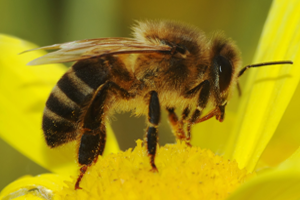|
Do you see/hear...?
|
| Activity
|
Adults
One or more adults are seen or heard moving about or at rest.
More...
For abundance, enter the number of individual animals observed in this phenophase.
|
|
|
Male adults
One or more adult males are seen moving about or at rest. For Apis mellifera, males (drones) are larger than the female worker bees and do not have a stinger.
For abundance, enter the number of individual animals observed in this phenophase.
|
|
|
Flower visitation
One or more individuals are seen visiting flowers or flying from flower to flower. If possible, record the name of the plant or describe it in the comments field.
For abundance, enter the number of individual animals observed in this phenophase.
|
| Reproduction
|
Mating
A male and female are seen coupled in a mating position, usually with the male on top of the female.
For abundance, enter the number of individual animals observed in this phenophase.
|
|
|
Nest building
One or more adults are seen building a nest or hive. For Apis mellifera, worker bees build a wax hive consisting of many adjacent hexagonal cells.
For abundance, enter the number of individual animals observed in this phenophase.
|
|
|
Drone cells
One or more drone cells are seen in a hive. For Apis mellifera, drone cells are wider than the worker cells and once capped, have a tall, domed top.
For abundance, enter the number of individual animals observed in this phenophase.
|
|
|
Nest provisioning
One or more adults are seen entering the nest with pollen. For Apis mellifera, pollen is carried on the hind legs in bright yellow, orange, or white pollen baskets.
For abundance, enter the number of individual animals observed in this phenophase.
|
|
|
Eggs
One or more eggs are seen in a nest or hive. For Apis mellifera, a small white egg is placed at the bottom of a hive cell.
For abundance, enter the number of individual animals observed in this phenophase.
|
| Development
|
Larvae
One or more larvae are seen moving about or at rest. For Apis mellifera, grub-like larvae develop within open hive cells.
For abundance, enter the number of individual animals observed in this phenophase.
|
|
|
Pupae
One or more pupae are seen in a cocoon or shell (puparium). For Apis mellifera, larvae become pupae when their hive cells are covered with a waxy cap.
For abundance, enter the number of individual animals observed in this phenophase.
|
|
|
Dead adults
One or more dead adults are seen.
For abundance, enter the number of individual animals observed in this phenophase.
|
| Method
|
Individuals in a trap
One or more individuals are seen caught in a trap.
For abundance, enter the number of individual animals observed in this phenophase.
|
